

Fatimid Caliphate. House of Knowledge. This article is about the Fatimid medieval university in Egypt .
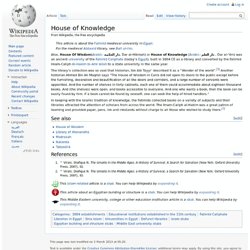
For the medieval Abbasid library, see Bait ul-ilm . Al-Hakim bi-Amr Allah. Abu ‘Ali Mansur Tāriqu l-Ḥākim , called Al-Hakim bi Amr al-Lāh ( Arabic : الحاكم بأمر الله ; literally "Ruler by God's Command"), was the third Fatimid caliph [ 1 ] and 16th Ismaili imam (996–1021).
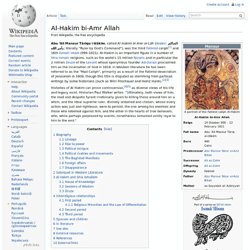
Al-Hakim is an important figure in a number of Shia Ismaili religions, such as the world's 15 million Nizaris and in particular the 2 million Druze of the Levant whose eponymous founder Ad-Darazi proclaimed him as the incarnation of God in 1018. In Western literature he has been referred to as the "Mad Caliph", primarily as a result of the Fatimid desecration of Jerusalem in 1009, though this title is disputed as stemming from partisan writings by some historians (such as Willi Frischauer and Heinz Halm). [ 2 ] [ 3 ] Histories of Al Hakim can prove controversial, [ 4 ] [ 5 ] as diverse views of his life and legacy exist.
Umar II. Umar ibn Abd al-Aziz (2 November 682 (26th Safar, 63 Hijri) – 31 January 720 (16th Rajab, 101 Hijri) [1] (Arabic: عمر بن عبد العزيز) was an Umayyad caliph who ruled from 717 to 720.
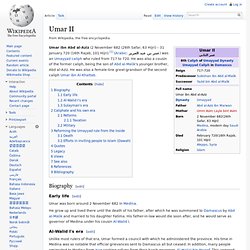
He was also a cousin of the former caliph, being the son of Abd al-Malik's younger brother, Abd al-Aziz. He was also a female-line great-grandson of the second caliph Umar ibn Al-Khattab. Biography[edit] Early life[edit] Umar was born around 2 November 682 in Medina. He grow up and lived there until the death of his father, after which he was summoned to Damascus by Abd al-Malik and married to his daughter Fatima. Al-Walid I's era[edit] Unlike most rulers of that era, Umar formed a council with which he administered the province. Sulayman's era[edit] Umar continued to live in Medina through the remainder of al-Walid's reign and that of Walid's brother Suleiman. Caliphate and his own era[edit] Reforms[edit] His other reforms include,[4] Taxation[edit] Umar Ibn Al-Khattab (ra): Speech After Conquering Jerusalem. Sulayman ibn Abd al-Malik. Sulayman bin Abd al-Malik (Arabic: سليمان بن عبد الملك) (c. 674 – 22 September 717) was an Umayyad caliph who ruled from 715 until 717.
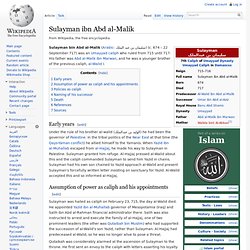
His father was Abd al-Malik ibn Marwan, and he was a younger brother of the previous caliph, al-Walid I. Early years[edit] Under the rule of his brother al-walid (الولید بن عبدالملك) he had been the governor of Palestine. In the tribal politics of the Near East at that time (the Qays-Yaman conflict) he allied himself to the Yamanis. When Yazid ibn al-Muhallab escaped from al-Hajjaj, he made his way to Sulayman in Palestine.
Caliphate. Umayyad Caliphate. The Umayyad Caliphate (Arabic: الخلافة الأموية, trans.

Al-Ḫilāfat al-ʾumawiyya) was the second of the four major Islamic caliphates established after the death of Muhammad. The caliphate was centered on the Umayyad dynasty (Arabic: الأمويون, al-ʾUmawiyyūn, or بنو أمية, Banū ʾUmayya, "Sons of Umayya"), hailing from Mecca. The Umayyad family had first come to power under the third Caliph, Uthman ibn Affan (r. 644–656), but the Umayyad regime was founded by Muawiya ibn Abi Sufyan, long-time governor of Syria, after the end of the First Muslim Civil War in 661 CE/41 AH. First Fitna. The Fitna began as a series of revolts fought against Ali ibn Abi Talib, the fourth of the Sunni Rightly Guided Caliphs It was caused by the controversial assassination of his predecessor, Uthman Ibn Affan.
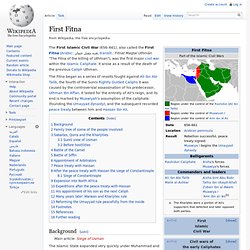
It lasted for the entirety of Ali's reign, and its end is marked by Muawiyah's assumption of the caliphate (founding the Umayyad dynasty), and the subsequent recorded peace treaty between him and Hassan ibn Ali. Background[edit] The Islamic State expanded very quickly under Muhammad and the first three caliphs. In 639 Muawiyah I was appointed the Governor of Syria by Umar after his elder brother Yazid ibn Abi Sufyan (Governor of Syria) died in a plague, along with Abu Ubaidah ibn al-Jarrah (the Governor before him) and 25,000 other people.
To stop the Byzantine harassment from the sea during the Arab-Byzantine Wars, in 649 Muawiyah set up a navy, manned by Monophysitise Christians, Copts and Jacobite Syrian Christians sailors and Muslim troops. "You are people from the Arabs. Diocese of the East. Roman diocese. A Roman or civil diocese (Latin: dĭœcēsĭs, from the Greek: διοίκησις, "administration") was one of the administrative divisions of the later Roman Empire, starting with the Tetrarchy.
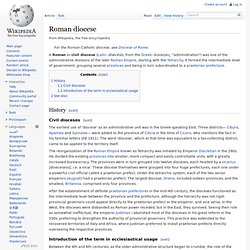
It formed the intermediate level of government, grouping several provinces and being in turn subordinated to a praetorian prefecture. History[edit] Bilad al-Sham. The historic geographic region of Syria or Greater Syria (often called Syria-Palestine or the Levant in modern literature, and Sham [ʃaːm] in traditional Arabic and Islamic literature) is usually defined as an area to the East of the Mediterranean Sea, West of the Euphrates River, North of the Arabian Desert and South of the Taurus Mountains.[1] The classical Arabic name for Syria is Sham (Arabic: الشام ash-Shām or al-Shām, also Cham under French influence).
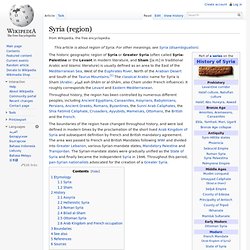
It roughly corresponds the Levant and Eastern Mediterranean. Throughout history, the region has been controlled by numerous different peoples, including Ancient Egyptians, Canaanites, Assyrians, Babylonians, Persians, Ancient Greeks, Romans, Byzantines, the Sunni Arab Caliphates, the Shia Fatimid Caliphate, Crusaders, Ayyubids, Mameluks, Ottomans, the British and the French.
The name Syria derives from the ancient Greek name for Syrians, Σύριοι Syrioi, which the Greeks applied without distinction to various Assyrian people. Abbasid Caliphate. House of Wisdom. This article is about the medieval Abbasid Library, Baghdad.
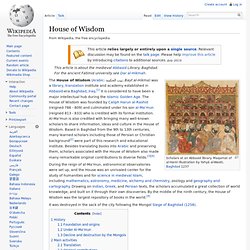
For the ancient Fatimid university see Dar al-Hikmah. Scholars at an Abbasid library. Science in the medieval Islamic world. Science in the medieval Islamic world was the science developed and practised during the Islamic Golden Age under the Umayyads of Córdoba, the Abbadids of Seville, the Samanids, the Ziyarids, the Buyids in Persia, the Abbasid Caliphate and beyond, spanning the period c. 800 to 1250.
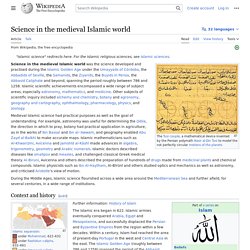
Islamic scientific achievements encompassed a wide range of subject areas, especially astronomy, mathematics, and medicine. Other subjects of scientific inquiry included alchemy and chemistry, botany, geography and cartography, ophthalmology, pharmacology, physics, and zoology. Medieval Islamic science had practical purposes as well as the goal of understanding.
Islamic Golden Age. Causes[edit] With a new, easier writing system and the introduction of paper, information was democratized to the extent that, probably for the first time in history, it became possible to make a living from simply writing and selling books.[4] The use of paper spread from China into Muslim regions in the eighth century CE, arriving in Spain (and then the rest of Europe) in the 10th century CE. It was easier to manufacture than parchment, less likely to crack than papyrus, and could absorb ink, making it difficult to erase and ideal for keeping records. Islamic paper makers devised assembly-line methods of hand-copying manuscripts to turn out editions far larger than any available in Europe for centuries.[5] It was from these countries that the rest of the world learned to make paper from linen.[6] Philosophy[edit] Ibn Rushd and Ibn Sina played a major role in saving the works of Aristotle, whose ideas came to dominate the non-religious thought of the Christian and Muslim worlds.
Harun al-Rashid. Harun al-Rashid ( Arabic : هارون الرشيد }; Hārūn ar-Rashīd ; English: Aaron the Upright, Aaron the Just , or Aaron the Rightly Guided ) (17 March 763 or February 766 – 24 March 809) was the fifth Arab Abbasid Caliph . His rule encompassed modern Iraq . His actual birth date is debated, and various sources give dates from 763 to 766.
He ruled from 786 to 809, and his time was marked by scientific , cultural and religious prosperity. Art and music also flourished significantly during his reign. He established the legendary library Bayt al-Hikma ("House of Wisdom"). [ 1 ] Since Harun was intellectually, politically and militarily resourceful, his life and the court over which he held sway have been the subject of many tales: some are claimed to be factual but most are believed to be fictitious. The family of Barmakids which played a deciding role in establishing the Abbasid Caliphate declined gradually during his rule. His Life [ edit ] Hārūn was born in Rey . Sokoto Caliphate. The Sokoto Caliphate is an Islamic spiritual community in Northern Nigeria, led by the Sultan of Sokoto (currently Sa'adu Abubakar).
Great Seljuq Empire. The Great Seljuq Empire (Persian: دولت سلجوقیان,Turkish: Büyük Selçuklu Devleti) was a medieval Turko-Persian[8][9][10][11][12][13][14][15] Sunni Muslim empire, originating from the Qynyq branch of Oghuz Turks.[16] The Seljuq Empire controlled a vast area stretching from the Hindu Kush to eastern Anatolia and from Central Asia to the Persian Gulf. From their homelands near the Aral sea, the Seljuqs advanced first into Khorasan and then into mainland Persia before eventually conquering eastern Anatolia. Turko-Persian tradition.